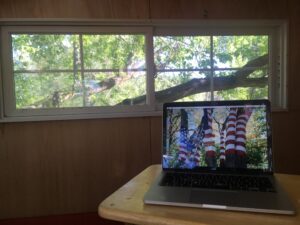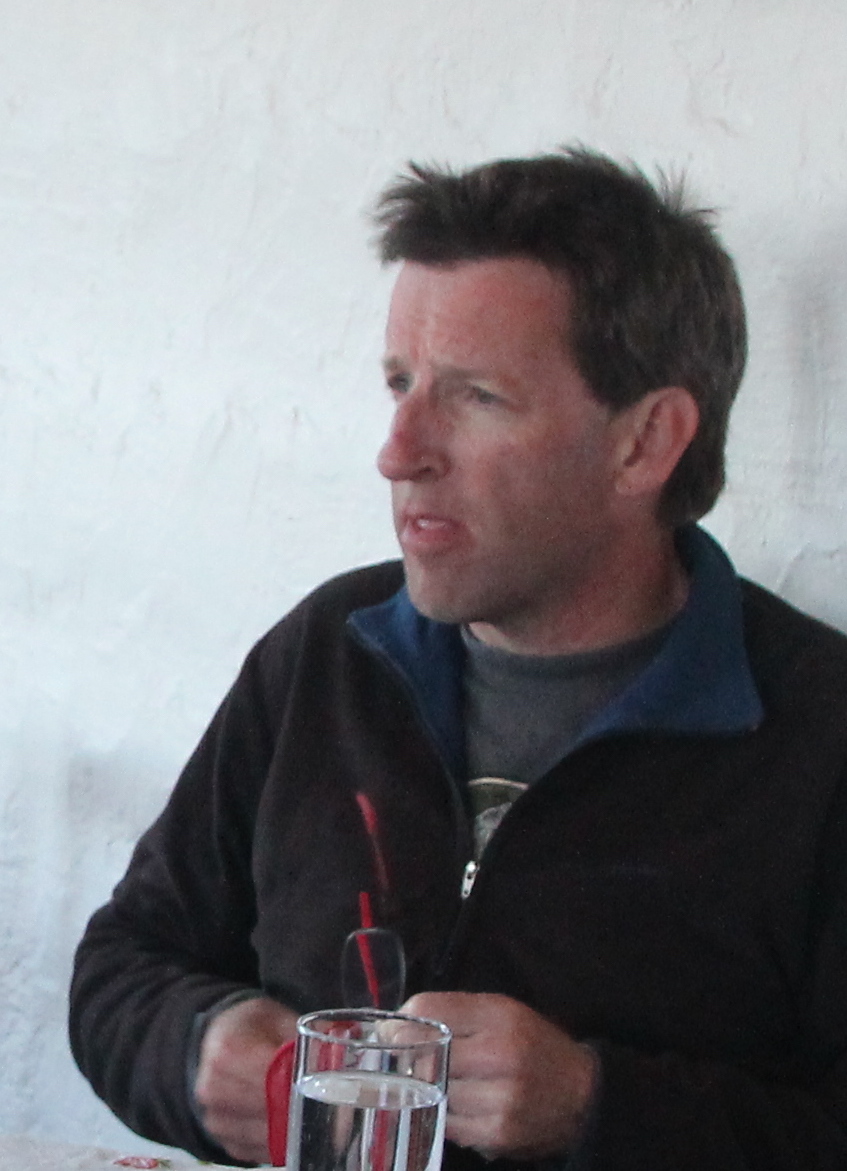 Until I had a treehouse to experience them in the gusty winds of late spring afternoons were always an ordeal to me. Back when as a young man I worked as a nomadic bird surveyor I found myself huddled in the meager shade of a government pickup on many afternoons, waiting for the wind to die down so that it would be possible to spot birds again, wearing a bandanna over my nose and mouth as if in a preview of a distant pandemic—but this was to keep out the billows of dust that tangoed over whatever stark desert tableland served as temporary home that day, whether Kingman’s Red Lake, the Kayenta flats, the chiseled Painted Desert badlands below the Aedi Aeechii cliffs, the overgrazed creosote flats that stretch between Aguila and Wenden. On the worst days the hot gusts and the acrid taste of dust in my teeth were almost enough to make me crave a new office job of the sort I’d previously left. But even indoors those windy days aren’t necessary much better. The humidity drops; the elm and pine branches jostle and sway outside; the sky is either a flat depthless overcast or a blue with an unfriendly metallic cast; noses are attuned to the slightest hint of wildfire smoke. The skin chaps; the nerves fray easily; voices, too, can readily take on a harsh note. The spring winds of northern Arizona are not quite as taxing as the ferocious autumnal Santa Anas of southern California, coming during a time of year when, as Joan Didion wrote in Slouching Toward Bethlehem, “Every voice seems a scream. It is the season of suicide and divorce and prickly dread, wherever the wind blows.” But even during a fresh green spring I am hard-pressed to think of a friend or acquaintance who finds much to praise on the windiest of afternoons.
Until I had a treehouse to experience them in the gusty winds of late spring afternoons were always an ordeal to me. Back when as a young man I worked as a nomadic bird surveyor I found myself huddled in the meager shade of a government pickup on many afternoons, waiting for the wind to die down so that it would be possible to spot birds again, wearing a bandanna over my nose and mouth as if in a preview of a distant pandemic—but this was to keep out the billows of dust that tangoed over whatever stark desert tableland served as temporary home that day, whether Kingman’s Red Lake, the Kayenta flats, the chiseled Painted Desert badlands below the Aedi Aeechii cliffs, the overgrazed creosote flats that stretch between Aguila and Wenden. On the worst days the hot gusts and the acrid taste of dust in my teeth were almost enough to make me crave a new office job of the sort I’d previously left. But even indoors those windy days aren’t necessary much better. The humidity drops; the elm and pine branches jostle and sway outside; the sky is either a flat depthless overcast or a blue with an unfriendly metallic cast; noses are attuned to the slightest hint of wildfire smoke. The skin chaps; the nerves fray easily; voices, too, can readily take on a harsh note. The spring winds of northern Arizona are not quite as taxing as the ferocious autumnal Santa Anas of southern California, coming during a time of year when, as Joan Didion wrote in Slouching Toward Bethlehem, “Every voice seems a scream. It is the season of suicide and divorce and prickly dread, wherever the wind blows.” But even during a fresh green spring I am hard-pressed to think of a friend or acquaintance who finds much to praise on the windiest of afternoons.
Of late we have had our own unique global season of prickly dread, and in the unexpected fullness of having far more unstructured hours at home than I have had since being a footloose young adult I have taken to using the backyard treehouse as my writing shack. Of all the unexpected discoveries of this unexpected time—no, more time at home does not mean that the house will be cleaner; though it’s not hard to maintain a minimum distance from strangers it’s very hard to do so with friends—perhaps the most unexpected is that in a treehouse I love the wind. Sometimes, I guess, the best approach to something you dislike is to lean into it.
Here it comes, surging through the poplars and elms in the next block even though here, a dozen feet up in a box elder, the air’s mainly still. I know that the treehouse is solidly placed over the tree’s central crotch, where four branches split off from a solid trunk. I know that it’s been five years since my son and I built the house, back when he was a young boy and I decided it would be a good summer for him to learn to think like an engineer or builder. I know that the tight little box we built has weathered plenty of summer gales and heavy winter snowstorms. But still, here it comes, and as the soughing of leaves and branches grows closer I feel the same anticipation that I used to in piloting a small sailboat on Lake Michigan and seeing the cat’s paws of a squall on the waves just ahead. Hang on . . . and here we go, creak and groan and squeak, the branches surging, every leaf in motion, the house’s movement itself reminiscent of a sailboat bounding on a fresh breeze. Crick crack, go the nails, the boards. Thump, goes an arm-thick branch just outside the wall, bumping rhythmically against the siding. A loose twig skitters on the metal roof. The place is alive. The tree is definitely alive, the stout almost-horizontal branch just outside the window rising up and down, giving me a brief train-station illusion that it’s perfectly still while I’m the one rocking and rolling.
The naturalist John Muir climbed a Douglas-fir once during a Sierra Nevada windstorm, and spent hours clinging high up in its foliage while the top swayed across an arc of twenty to thirty degrees, like a sailor gripping the rigging high up on the yardarm of a clipper ship. He loved it, of course, and wrote that he learned from the experience a new appreciation of trees as fellow travelers: “it never occurred to me until this storm-day, while swinging in the wind, that trees are travelers, in the ordinary sense. They make many journeys, not very extensive ones, it is true; but our own little comes and goes are only little more than tree-wavings.”
Rocking gently and not all that far off the ground in a backyard box elder hardly compares to Muir’s frontline experience. But we’re living at a time when we are all buffeted by the new and the unexpected, wondering what in our lives and in our society is supple and giving, what is too brittle and subject to breakage. I can’t claim too much wisdom from the simple act of sitting in a backyard tree, though it’s certainly an experience I’d recommend. But what I can report is what reassures me when I feel a big gust coming and, inevitably, experience an unstoppable gut-level worry that this time the branches are going to break: namely, that the reason the branches don’t break, at least so far, is that every leaf and twig gives a bit when the wind comes, moving away from the spot it’s been so that the whole tree can weather the storm together.

